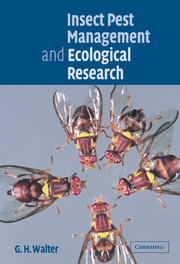Book contents
- Frontmatter
- Contents
- Preface
- Acknowledgements
- 1 Introduction
- Part 1 The place and nature of insect ecology research for IPM
- 2 Pest management as an applied science: the place of fact, theory and application
- 3 Historical trends in pest management: paradigms and lessons
- 4 IPM: a diverse, interrelated suite of socioeconomic and scientific problem-solving activities
- 5 An ecological underpinning for IPM
- Part 2 Specific directions in insect ecology research for IPM
- Part 3 Synopsis: Ecological research for IPM today
- References
- Index
4 - IPM: a diverse, interrelated suite of socioeconomic and scientific problem-solving activities
Published online by Cambridge University Press: 22 August 2009
- Frontmatter
- Contents
- Preface
- Acknowledgements
- 1 Introduction
- Part 1 The place and nature of insect ecology research for IPM
- 2 Pest management as an applied science: the place of fact, theory and application
- 3 Historical trends in pest management: paradigms and lessons
- 4 IPM: a diverse, interrelated suite of socioeconomic and scientific problem-solving activities
- 5 An ecological underpinning for IPM
- Part 2 Specific directions in insect ecology research for IPM
- Part 3 Synopsis: Ecological research for IPM today
- References
- Index
Summary
Integrated Pest Management has become largely a delivery system with little attention to basic biological understanding of the crop/pest/natural enemy system.
j. r. cate (1990, p. 29)Introduction
The previous chapter analysed how society has been led to deal with pests at different stages in the development of modern pest management. Structured ways of thought, called paradigms, tend to direct efforts against pests and also direct the research needed to improve those efforts. Integrated pest management is accepted as the driving force behind current pest management practice and is seen as the guiding principle in pest management research (Dent, 2000; Kogan, 1998).
Contemporary analyses of IPM tend to concentrate on the successes of IPM and on other positive aspects. Although encouraging, this approach is not necessarily the best or most helpful in identifying and redressing the problems that still exist. A more introspective approach is needed if deficiencies are to be identified and targeted for improvement. One of the deficiencies noted in previous chapters has not been singled out for attention to any great extent in the IPM literature, namely the poorly articulated relationship between the practice of IPM and ecological theory. The aim of the current chapter is to scrutinise the research angles that relate to IPM and seek a realistic context for each of them. Research on pest or beneficial species for IPM purposes takes several distinct forms, depending on what problem area is being addressed.
- Type
- Chapter
- Information
- Insect Pest Management and Ecological Research , pp. 72 - 88Publisher: Cambridge University PressPrint publication year: 2003



